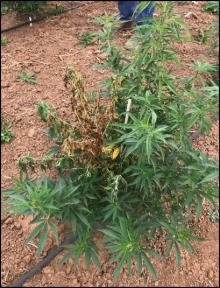See:
Hemp (Cannabis sativa) - Verticillium Wilt
By C. M. Ocamb
Cause The fungi, Fusarium oxysporum f. sp. cannabis and Fusarium oxysporum f. sp. vasinfectum, which may overwinter on infected hemp residues or as durable spores (chlamydospores) in soil. Both of these fungi can be seedborne. Between these two wilt strains, F. oxysporum f. sp. vasinfectum can incite wilt in other crop species including cotton and bean, while F. oxysporum f. sp. cannabis is host specific and causes wilt only on cannabis. These fungi can be spread through soil movement on equipment, tools, and footwear as well as infested soil being windborne or waterborne. These pathogens can be introduced into a new region through the movement of infected transplants or the sowing of infected seed. Fusarium oxysporum can also produces additional spore types (macro- and microconidia) that can be moved with wind or water.
Symptoms Plants are susceptible at any stage and the initial infection typically occurs through a plant root. Early symptoms include yellowing of lower leaves, sometimes one-sided or V-shaped in appearance, and stunting of the plant. Leaves may die, and leaf yellowing as well as defoliation may progress up an affected plant. Wilting can involve the entire shoot or only the portions of the plant aboveground where the associated vascular elements are affected. Wilting of cannabis plants is observed more commonly once flowering commences and yellowing spreads to younger leaves. Often the entire plant dies and remaining stems are silvery-tan in color. Dark-brown to blackish discoloration can found around vascular elements in roots and in stems. Vascular discoloration precedes wilting symptoms. A brown rot may develop on the tap root or the lower stem of affected plants. The root system may also be stunted with a brown rot of the lateral roots present.
Cultural control
- Plant pathogen-free seed in pathogen-free soil.
- Rotate out of hemp for at least 4 years if wilt is caused by Fusarium
- Avoid establishment of hemp fields in soils where previous hemp wilt occurred in the previous three years.
- Avoid planting in heavy, poorly draining soils.
- Avoid excessive irrigation, especially during the spring, but also minimize moisture stress, particularly during flowering.
- Apply sufficient nitrogen for crop needs, but avoid excessive fertilization of this nutrient and use a nitrate form rather than ammonia.
- Remove and destroy diseased plants while avoiding contact with healthy plants; this will decrease the build-up of durable fungal structures. Burn or deeply bury infected plants.
- Clean tools and equipment between fields so that there are no remaining soil or plant residues that can lead to pathogen spread.
- Soil solarization can weaken and reduce soilborne populations of Verticillium. See http://westernipm.org/index.cfm/ipm-in-the-west/agriculture/soil-solarization-in-the-pacific-northwest/ and https://aces.nmsu.edu/programs/sare/documents/2019_parke.pdf for more information on soil solarization in the Pacific Northwest. Soil solarization can also help with the management of other soilborne pathogens as well as weed seed banks in the soil.






